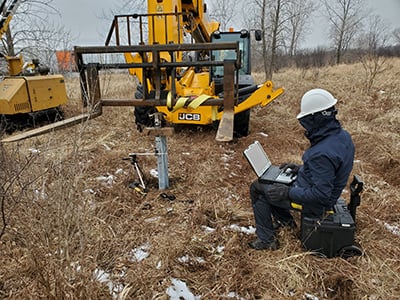How do you know if your building or land is well-suited for a solar installation?
An important step in assessing the feasibility and suitability of any commercial solar installation is having the site’s physical and electrical infrastructure audited early in the project development process. This evaluative process is managed on location by a trained solar technician who may work in tandem with other engineers to gather all necessary data. A site assessment not only helps confirm the project is viable, it can also inform solar project engineers of other factors that need to be considered in the system’s final design. If done well, the site assessment can also provide very useful and valuable information to the business owner about the facility or property’s overall health and makeup.
In SunPeak’s project development process, a site assessment is conducted after a preliminary project design and budget has been shared with a customer and approved. Solar systems can be installed on a rooftop and/or on available land. Depending on what type of location is being considered, our goals for a site assessment will include evaluation of the following:
Physical and Geological Factors
The ground site or facility’s location, physical dimensions, age, elevation, topography, vegetation and soil composition can all become considerations in the design and construction of a system. Depending on the site location(s) to be considered, a GPS survey, soil composition test, structural assessment, shading analysis and seismic study could all be completed in this process. These tests will help project engineers determine the optimal location for the solar arrays as well as the most effective style of mounting equipment to be used.
Electrical and Equipment Factors
A site assessor will also carefully document the age, quality and components in the site’s current electrical infrastructure. Things that will be noted include the location of the existing electrical room and its proximity to the proposed solar site, the voltage (V) of the incoming power supply at the interconnection point and the number of phases, and the capacity of the main breaker.
Likewise, documentation will be done for other equipment that may be in or near the proposed project space, including HVAC systems, roof drains, vents and other equipment that would affect solar placement due to shading or that may independently require access and maintenance. Electrical specifications for very large motors, generators or other equipment will also be considered, as well as the possible wiring and cabling configuration that will be needed for the solar system.
With all of the collected information, the development team can determine how solar will deliver energy through the facility to the interconnection point, optimize inverter placement, and subsequently develop a monitoring plan to track the health and energy production of the system over time.
Some customers may have independently commissioned an Arc Flash Study for their facility. This test, a common workplace hazard prevention analysis, evaluates different elements of the facility's overall power system. The data captured within this test is very useful to solar project developers and should be shared if available. The information in an arc flash study can expedite some of the other expected data collection efforts typically performed within the site assessment.
Communicating Assessment Results to the Customer
At SunPeak, our internal site assessment team reviews the data with project engineers and then consolidates the findings into a report that is shared with the customer.
Occasionally, the results of the site assessment will reveal that restorative or structural work is necessary before solar construction can begin. For example, a roof’s material, condition or age may require a full or partial roof replacement. SunPeak’s team consults with the customer to develop safe and cost-effective solutions and offer related resources and information wherever helpful. For example, in the case of a potential roof replacement, the customer may not know that those additional costs qualify as a solar project expense and are therefore eligible for the 26% dollar-for-dollar federal tax credits (Investment Tax Credit).
Even if the site assessment findings do not indicate any solar-related project limitations, most customers and their facility engineers find the information useful and handy for other facility-related investments and potential upgrades.
How a Site Assessment Benefits the Customer
If a thorough site assessment has been conducted, project engineers will have all necessary information to confidently deliver a final system design and the associated project budget. Customers can feel assured that their solar developer is protecting their investment dollars by developing a system that considers all site-related variables in order to maximize energy production and meet or exceed the customer’s goals.
At SunPeak, the site assessment process is an included service because we believe starting with a strong foundation of quality information and working directly with our customers is essential to building high-quality, reliable and long-lasting systems.
Please reach out if you have questions about site assessments or other aspects of solar development, construction or maintenance. We’re always here to help.
